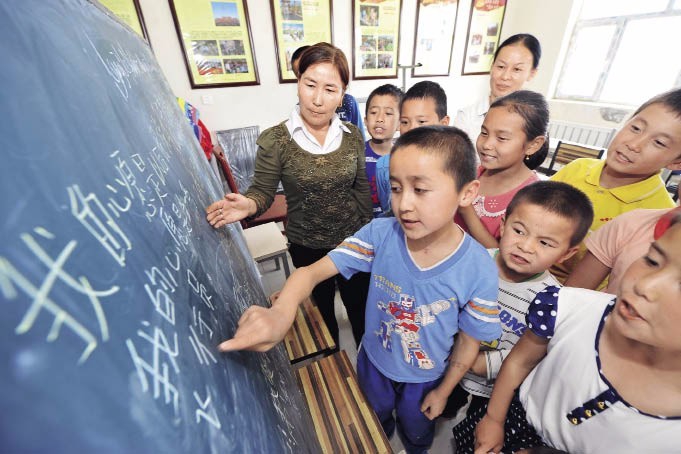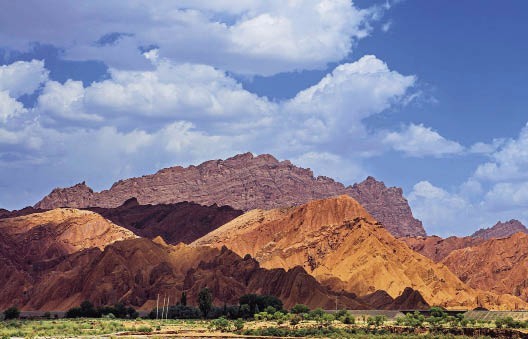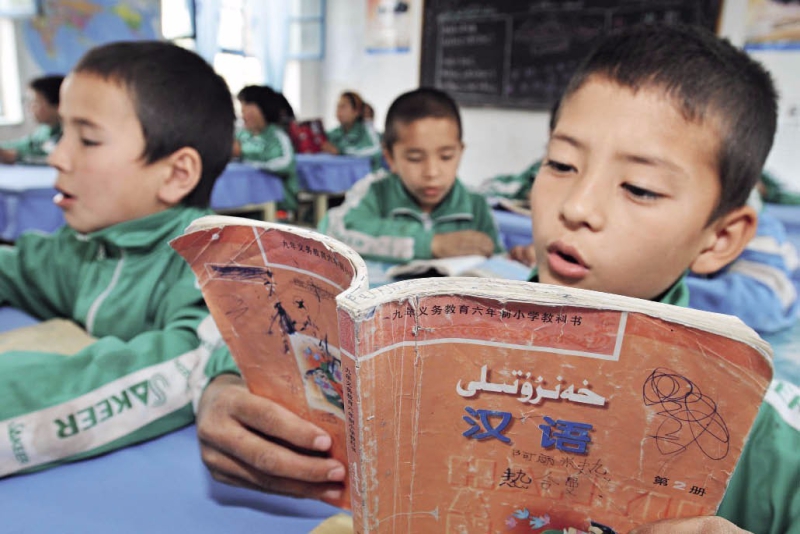A Uygur boy writes down his wish on the blackboard for the future in Chinese on May 21, 2017, at a school in Xinjiang, where he receives bilingual education.

A Uygur boy writes down his wish on the blackboard for the future in Chinese on May 21, 2017, at a school in Xinjiang, where he receives bilingual education.
Reading a map of Xinjiang is easy as everything seems to be a desert landscape, with warm pastel colors, incredible distances, dots that look like cities or rather villages.
Let’s talk about those dots on the map. Before arriving in Kucha, you have to go across Korla. Even though we did not stay very long, we spent some time there. People’s standards of living are surprisingly developed, and constantly evolving. Korla is the seat of the Bayingolin Mongol Autonomous Prefecture, a pretty large prefecture covering a larger area than France. The natives are ethnic Dzungar, accounting for four percent of the population. Their name literally means “left hand.” They are so called because they are Western Mongols, as opposed to Eastern Mongols. Most of them live in the region between the Altai Mountains and Tianshan Mountains. Today, Korla is still this amazing crossroad of exchanges. Everything goes through the city: the railway and roads connecting Urumqi, Kashgar, and Lanzhou. It buzzes with activities; it pulses with traffic in every direction. The Kongque River originates from the Tianshan and flows across the heart of the city, bringing coolness in summer which sooths the exhausted travelers.
Kucha is an amazing city. Passing through mountains along the road in the midst of the deserts, it appears like a wide open space stretching as far as the eye can see. This city strikes a clever balance between the past and the future, and between the secular and religious world. It is both an ancient city and a fast-developing urban center. It is a place travelers heading for Hotan and Kashgar usually pass by.
A former prosperous city-state, Qiuci (a name for Kucha in ancient times) was a major Buddhist center. During the Tang Dynasty (618-907), this place was renowned for its music and dances. Kumarajiva (344-413) was born here. The son of an Indian man and local princess, he was the first great translator of the Buddhist sutras from Sanskrit to Chinese. To understand this city, we must take our time and understand its people by spending time with them. The first question that comes to mind is that of education. How in this city, in this very specific location, is education conceived? Geographically far from Beijing and close to Central Asia, what is the most important thing in terms of education? In an agricultural region, what dominates most? How to impart a taste for education, for culture?

The imposing Kucha Grand Canyon.
Bilingualism Starts from Toddlers
Ayiguli Turdi is the headmistress of a bilingual nursery school. She was proud to show us around this multicolored paradise. Every corner abounded with children chattering, frolicking. Everything is in its place: children play, learn, and words erupt everywhere, in all sorts of languages. It is a beautiful place. Turdi is keen to show visitors around, so we take a look at the classrooms, the teachers’ room, etc.
“Our school was built in 2009 and opened in September 2010. There are 180 children including both Uygur and Han students, and 13 teachers for five classes. The area of the school is 1,100 square meters with a large green space. All classes are equipped with teaching equipment, toys, and musical instruments, among other things.”
It reminded me of some figures from Xinhua:
From 2011 to 2015, Xinjiang built 2,500 new bilingual nursery schools in rural areas, bringing the region’s pre-school education penetration rate to 77 percent, or 480,000 preschoolers, according to authorities.
To me, these incredible figures fully show the primary role of education in China. They also highlight the government’s efforts to leave no child behind. Since the 1990s, the government has introduced bilingual education (Mandarin and Uygur) in Xinjiang.
Behind Turdi’s smooth manner lies a strong, energetic woman who loves her job. She became a primary school teacher in 2015. Prior to this, she attended a training course in preschool education at a teacher training college of the Bayingolin Mongol Autonomous Prefecture. Today, she has already been working in education for eight years.
“When our school opened, bilingual education did not attract much attention. The reason why parents enrolled their children in nursery school was only because they did not have time to look after them. Their goal was just to have someone take care of their children. After learning Mandarin for some time, more and more children were able to speak it fluently. They were excellent in primary school. Sometimes some children were able to act as interpreters for their parents when going shopping with them, for example. Seeing this, parents are now very supportive of bilingual education in our school.”

Primary school students in their bilingual (Mandarin and Uygur) class in Xinjiang.
Getting More Experienced
“Every month, our school organizes parent-teacher meetings. During these meetings, we showcase the performance of our pupils who have performed great in primary school, so parents are very excited. During the summer, many parents come to learn about the new school term. The government grants subsidies for school meals. For each student, we can get subsidies of up to RMB 1,000 for food and RMB 500 for school operations. Children attend school free of charge. They are provided with two meals at school every day. In the morning, we prepare snacks for them like fruit and milk. Parents love our nursery school. Children can learn a lot here,” Turdi said.
When we asked her to elaborate on the changes that have taken place compared with the past, Turdi smiled. No doubt my question seemed naive to her. But to our Western eyes, we found it hard to work it out. For us, education has become a norm, something very commonplace. We no longer ask ourselves whether a child has had little or no schooling. Our system is of course not the best, and it certainly even needs some rethinking. But that’s why this exchange of views is essential to me.
“Before, rural areas had no nursery schools. Children had to go straight to primary school. I, for example, have never been to a nursery school. And when I was in the primary school, we only had shabby tables and chairs in a totally poor setting. But look at what we have today, these little tables and chairs for children, brand new and pretty. They are provided by the government. Before, nursery schools were only found in the city. Now, each village has its nursery school, and everything is free.”
“Our nursery school looks after children aged five to six years old from three villages. But it is not big enough to meet the needs of the local people. We only have five classes, so the waiting list is long. We asked the local bureau of education to increase the number to nine. Every September, parents arrive in droves to enroll their children. They think that bilingual education is useful for primary schools. With regard to bilingual education, we are getting more and more experienced. We continue to work in this direction to develop new pedagogical methods.”
___________
SONIA BRESSELER is a French philosopher and epistemologist.